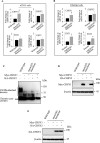TMEM165 a new player in proteoglycan synthesis: loss of TMEM165 impairs elongation of chondroitin- and heparan-sulfate glycosaminoglycan chains of proteoglycans and triggers early chondrocyte differentiation and hypertrophy
- PMID: 34930890
- PMCID: PMC8688514
- DOI: 10.1038/s41419-021-04458-1
TMEM165 a new player in proteoglycan synthesis: loss of TMEM165 impairs elongation of chondroitin- and heparan-sulfate glycosaminoglycan chains of proteoglycans and triggers early chondrocyte differentiation and hypertrophy
Abstract
TMEM165 deficiency leads to skeletal disorder characterized by major skeletal dysplasia and pronounced dwarfism. However, the molecular mechanisms involved have not been fully understood. Here, we uncover that TMEM165 deficiency impairs the synthesis of proteoglycans by producing a blockage in the elongation of chondroitin-and heparan-sulfate glycosaminoglycan chains leading to the synthesis of proteoglycans with shorter glycosaminoglycan chains. We demonstrated that the blockage in elongation of glycosaminoglycan chains is not due to defect in the Golgi elongating enzymes but rather to availability of the co-factor Mn2+. Supplementation of cell with Mn2+ rescue the elongation process, confirming a role of TMEM165 in Mn2+ Golgi homeostasis. Additionally, we showed that TMEM165 deficiency functionally impairs TGFβ and BMP signaling pathways in chondrocytes and in fibroblast cells of TMEM165 deficient patients. Finally, we found that loss of TMEM165 impairs chondrogenic differentiation by accelerating the timing of Ihh expression and promoting early chondrocyte maturation and hypertrophy. Collectively, our results indicate that TMEM165 plays an important role in proteoglycan synthesis and underline the critical role of glycosaminoglycan chains structure in the regulation of chondrogenesis. Our data also suggest that Mn2+ supplementation may be a promising therapeutic strategy in the treatment of TMEM165 deficient patients.
© 2021. The Author(s).
Conflict of interest statement
The authors declare no competing interests.
Figures








References
Publication types
MeSH terms
Substances
LinkOut - more resources
Full Text Sources
Medical
Molecular Biology Databases
Research Materials

